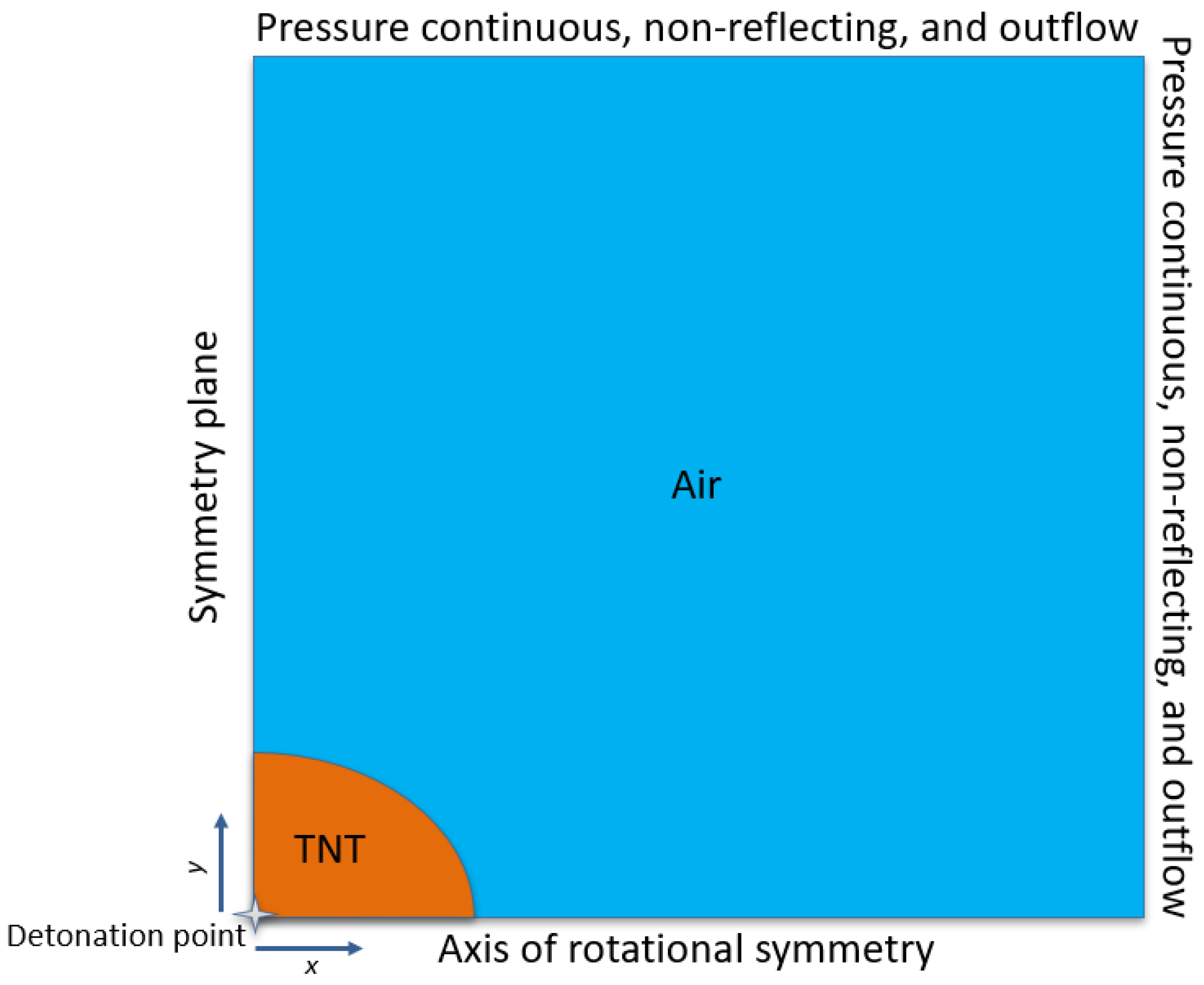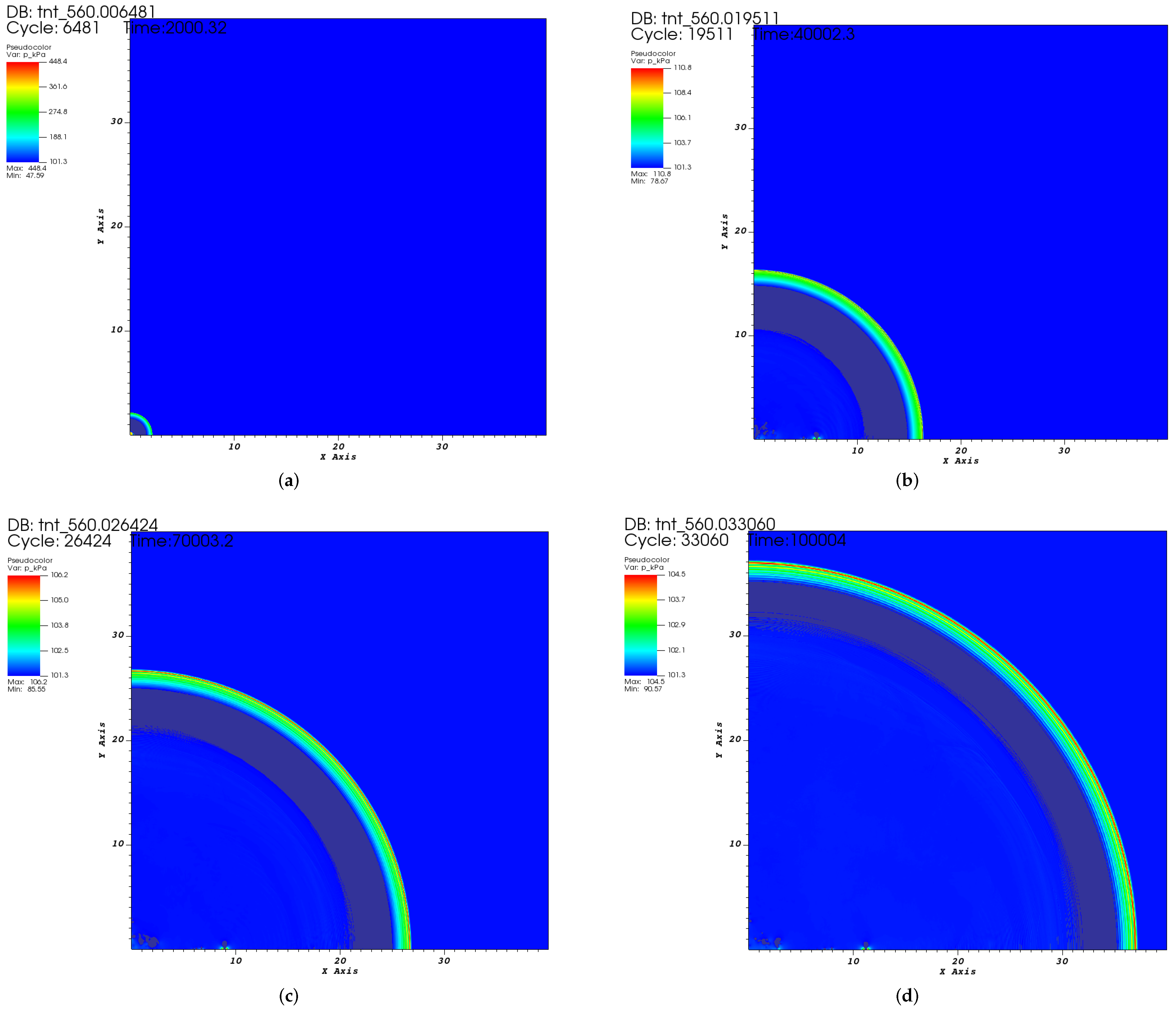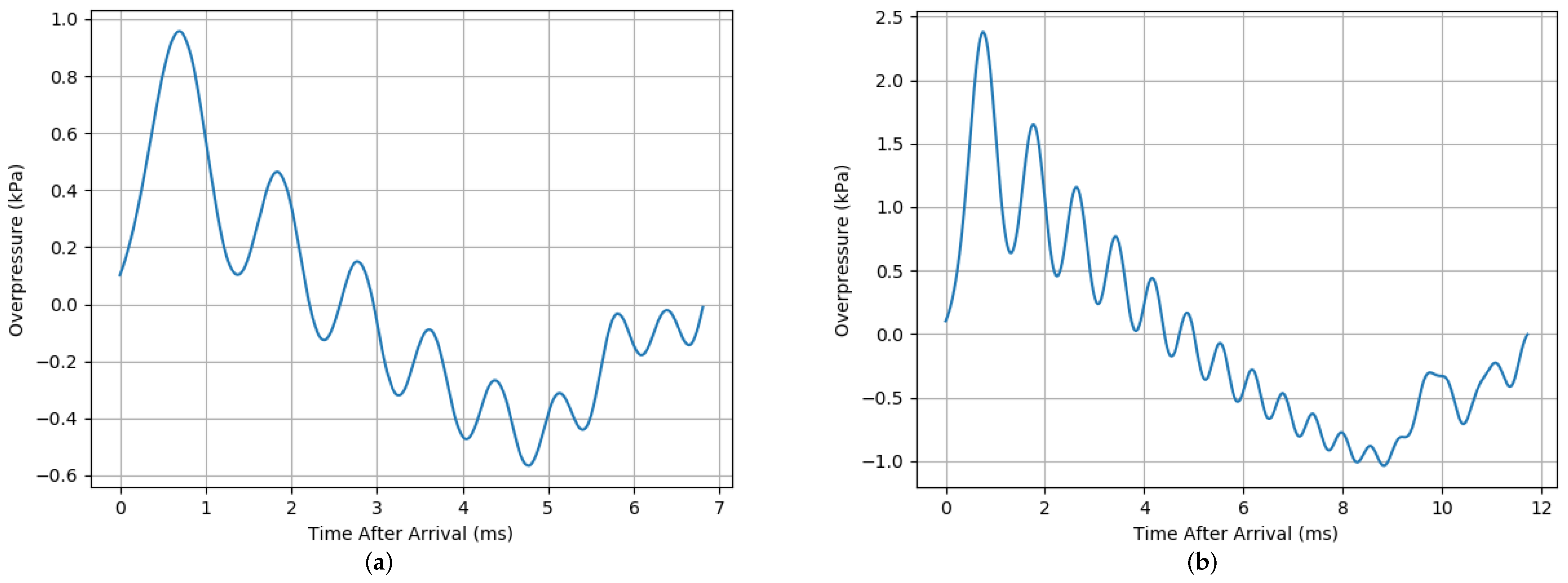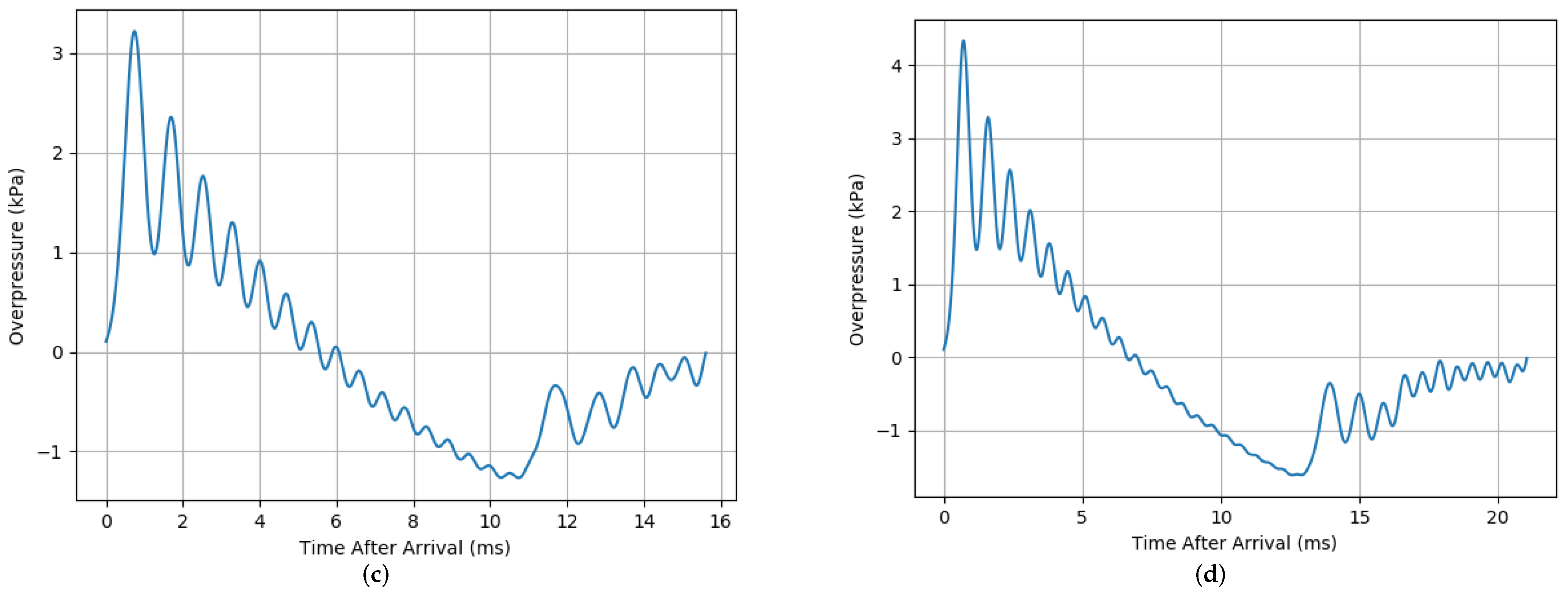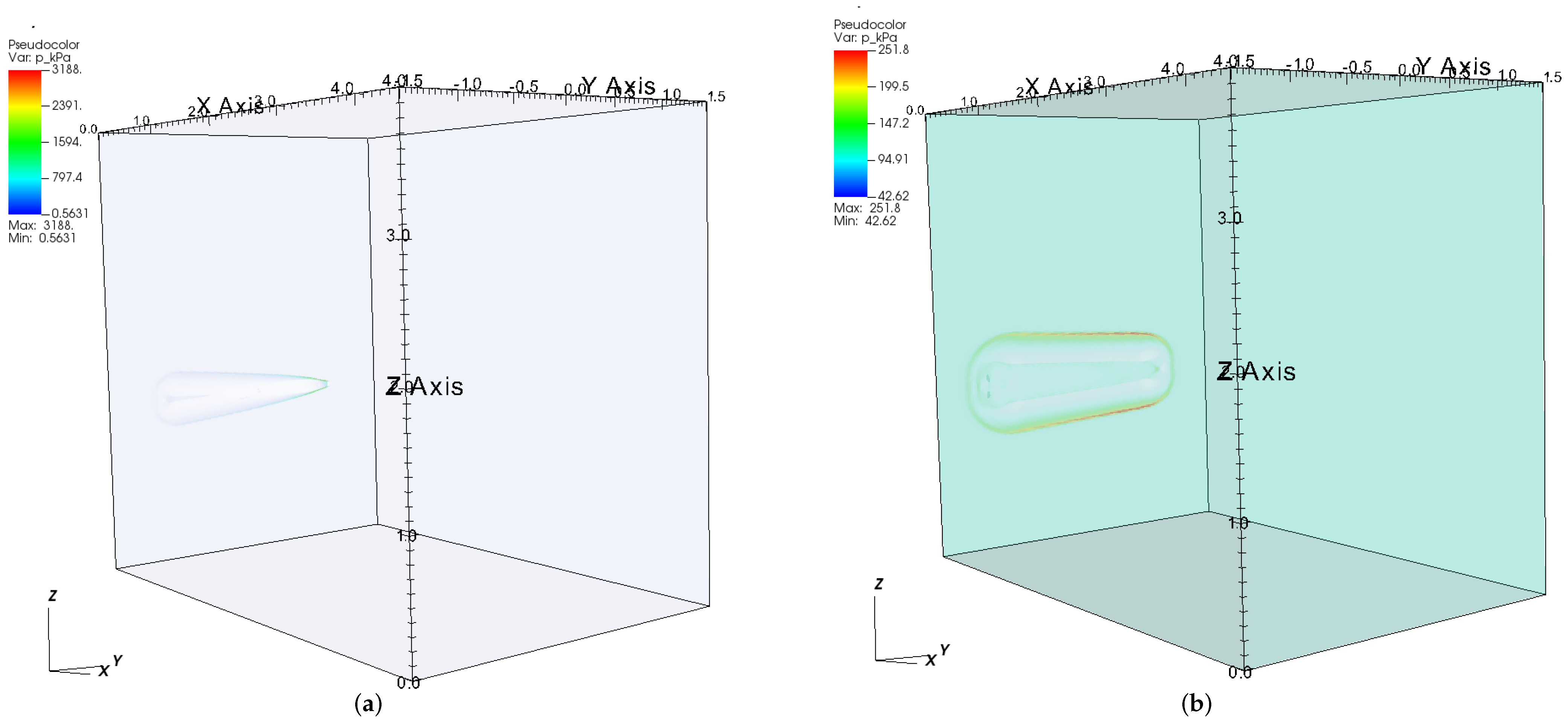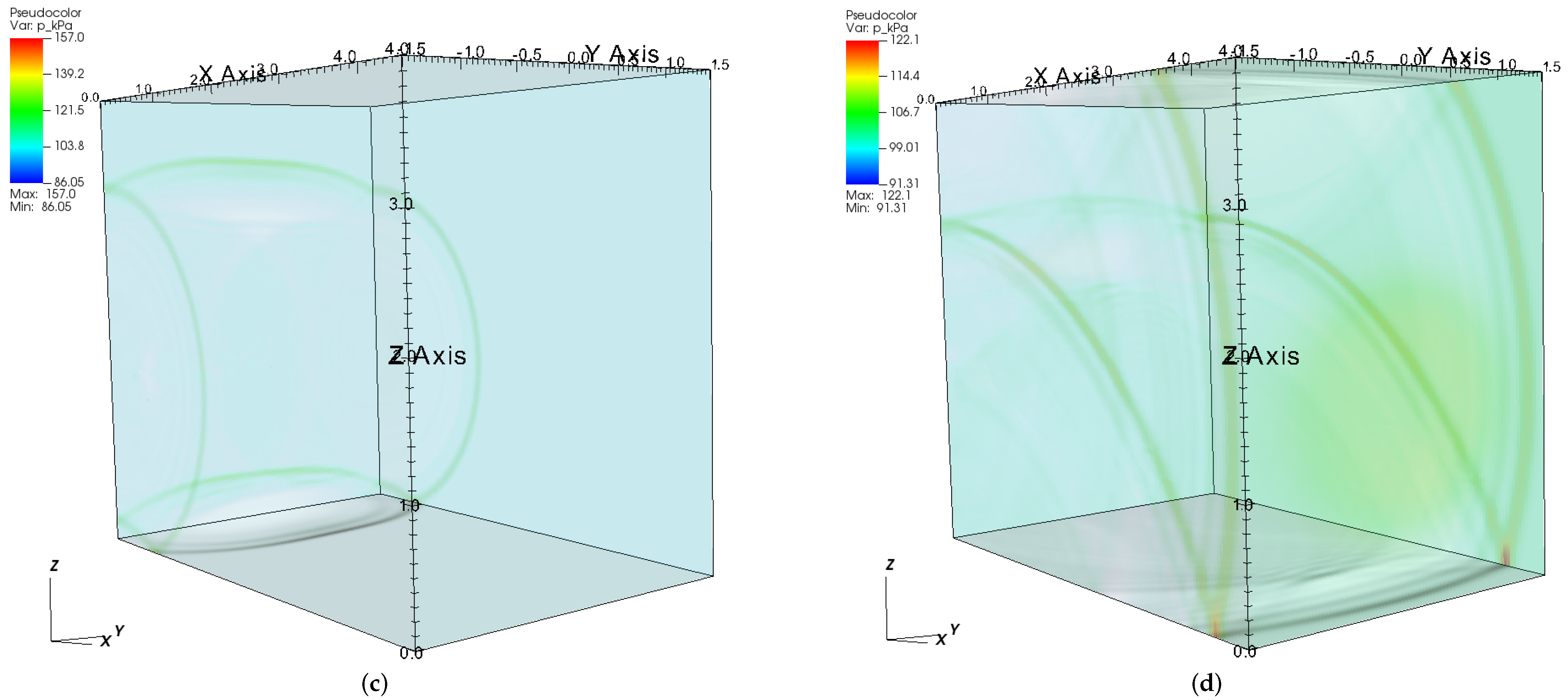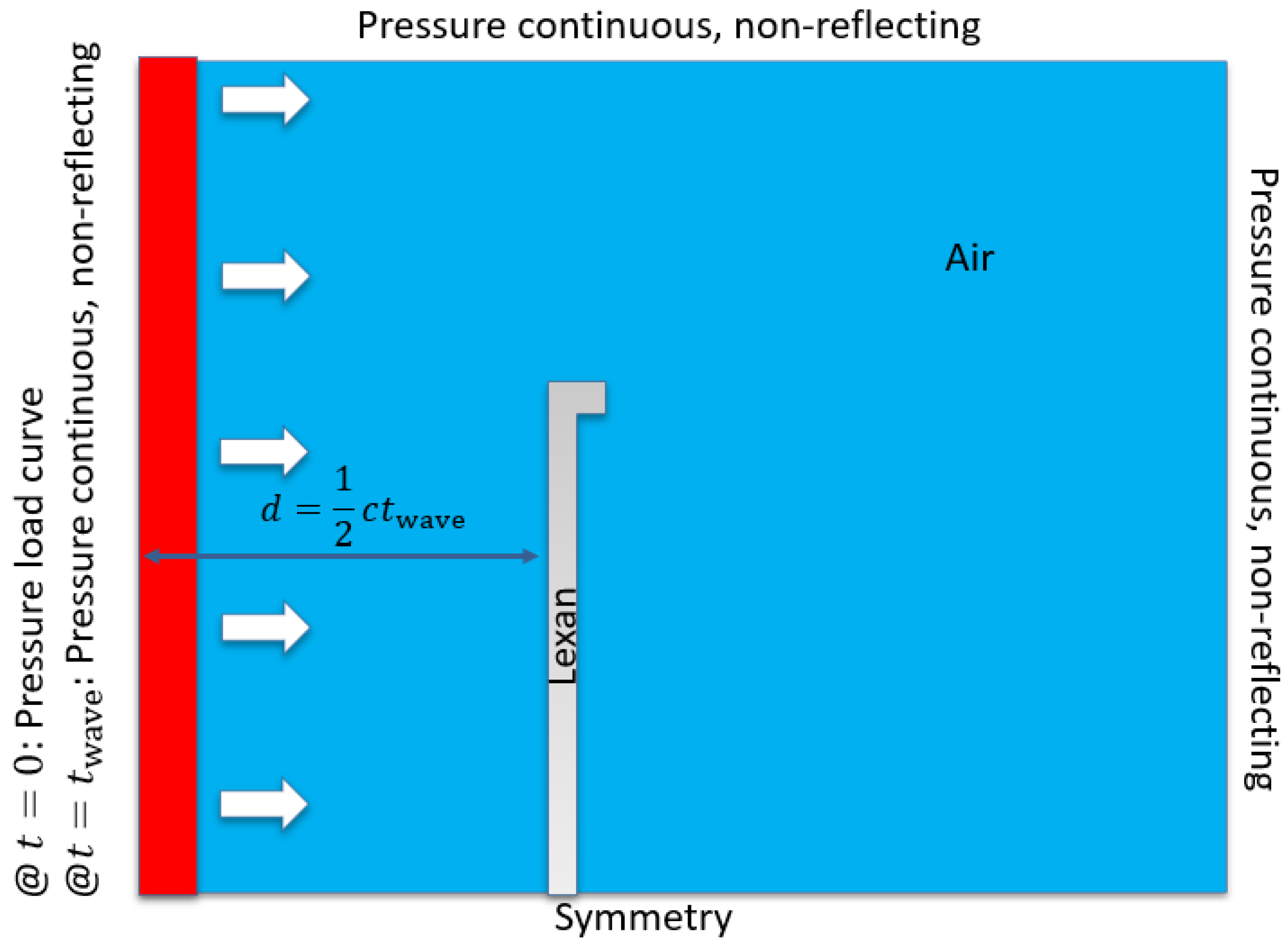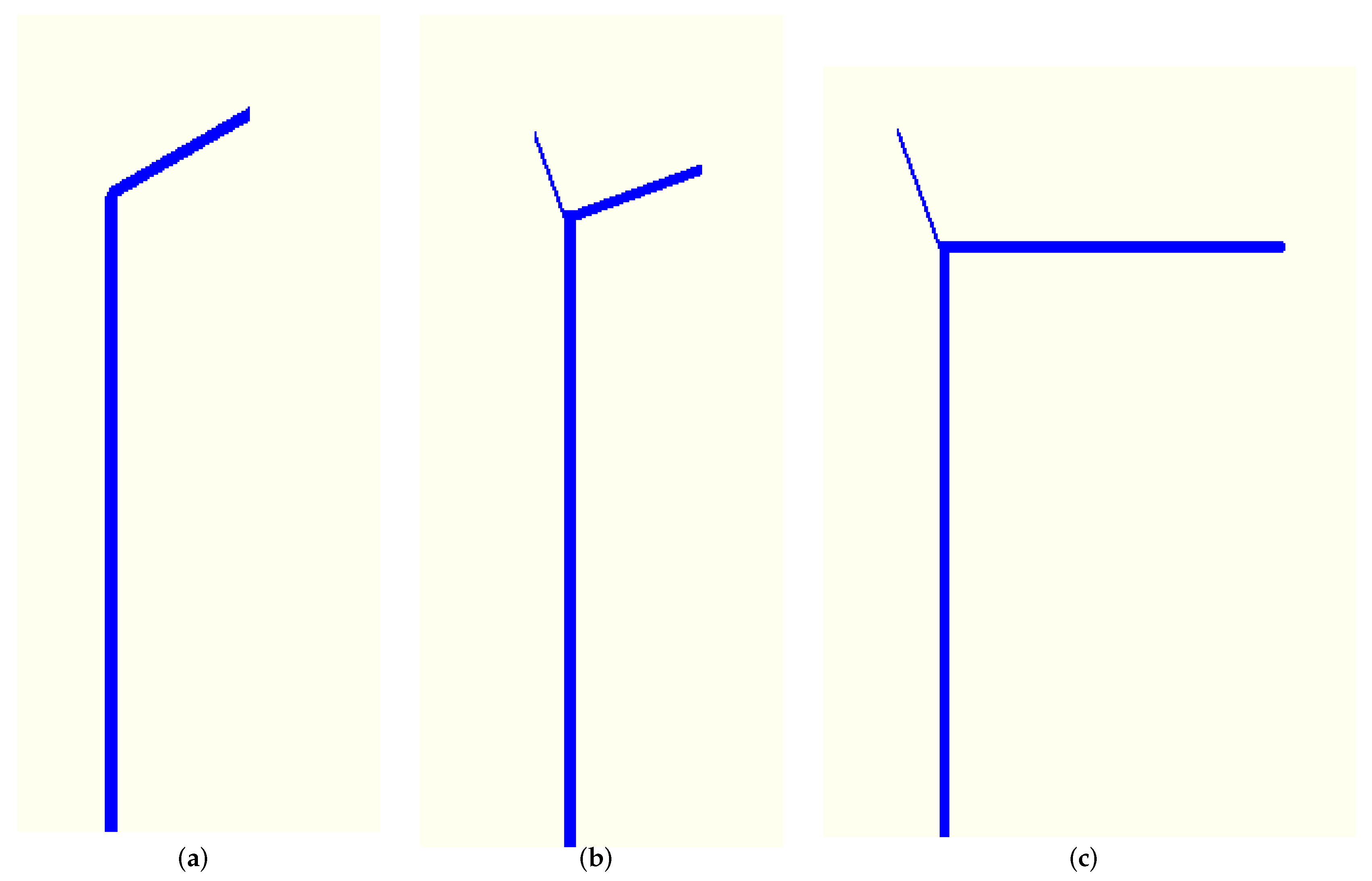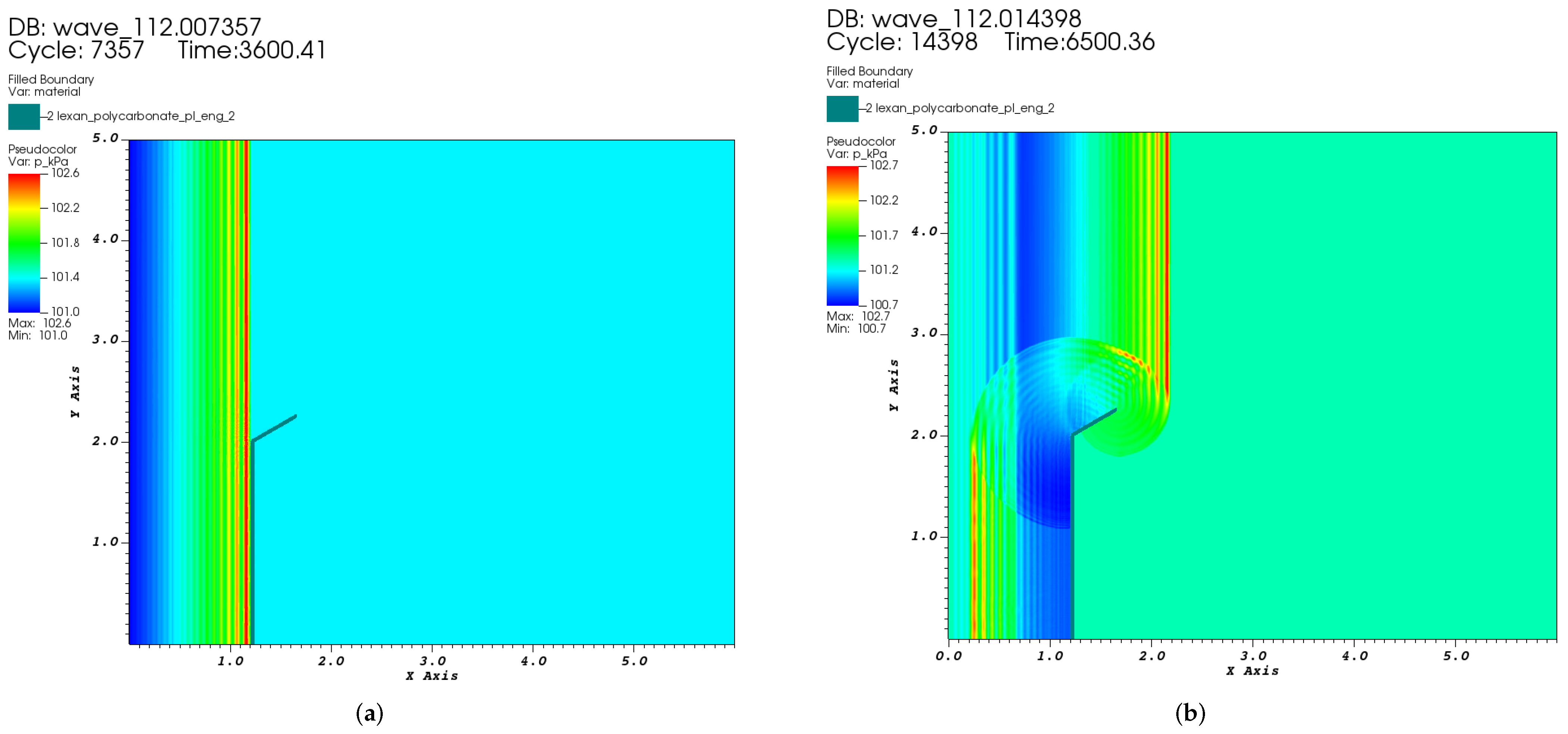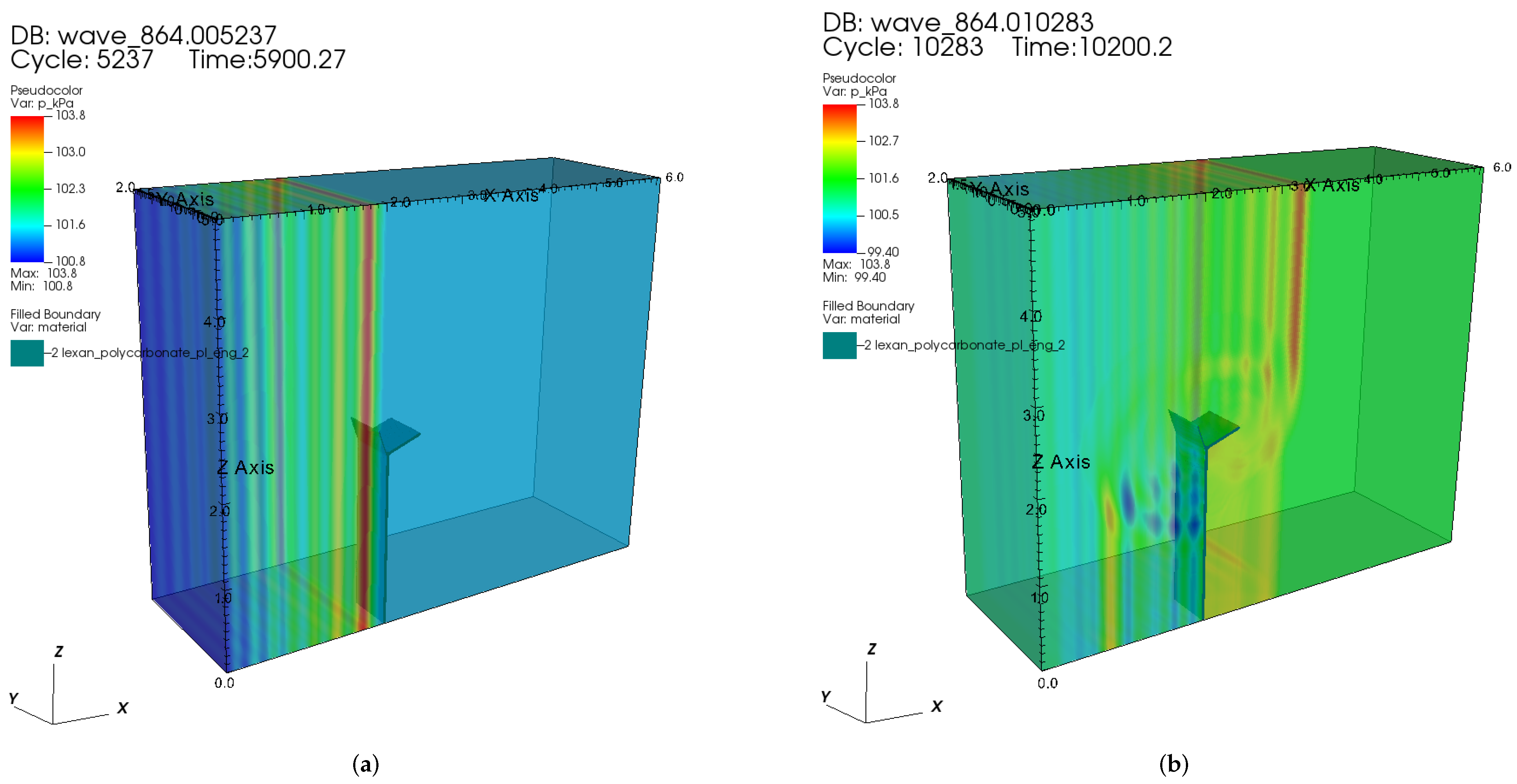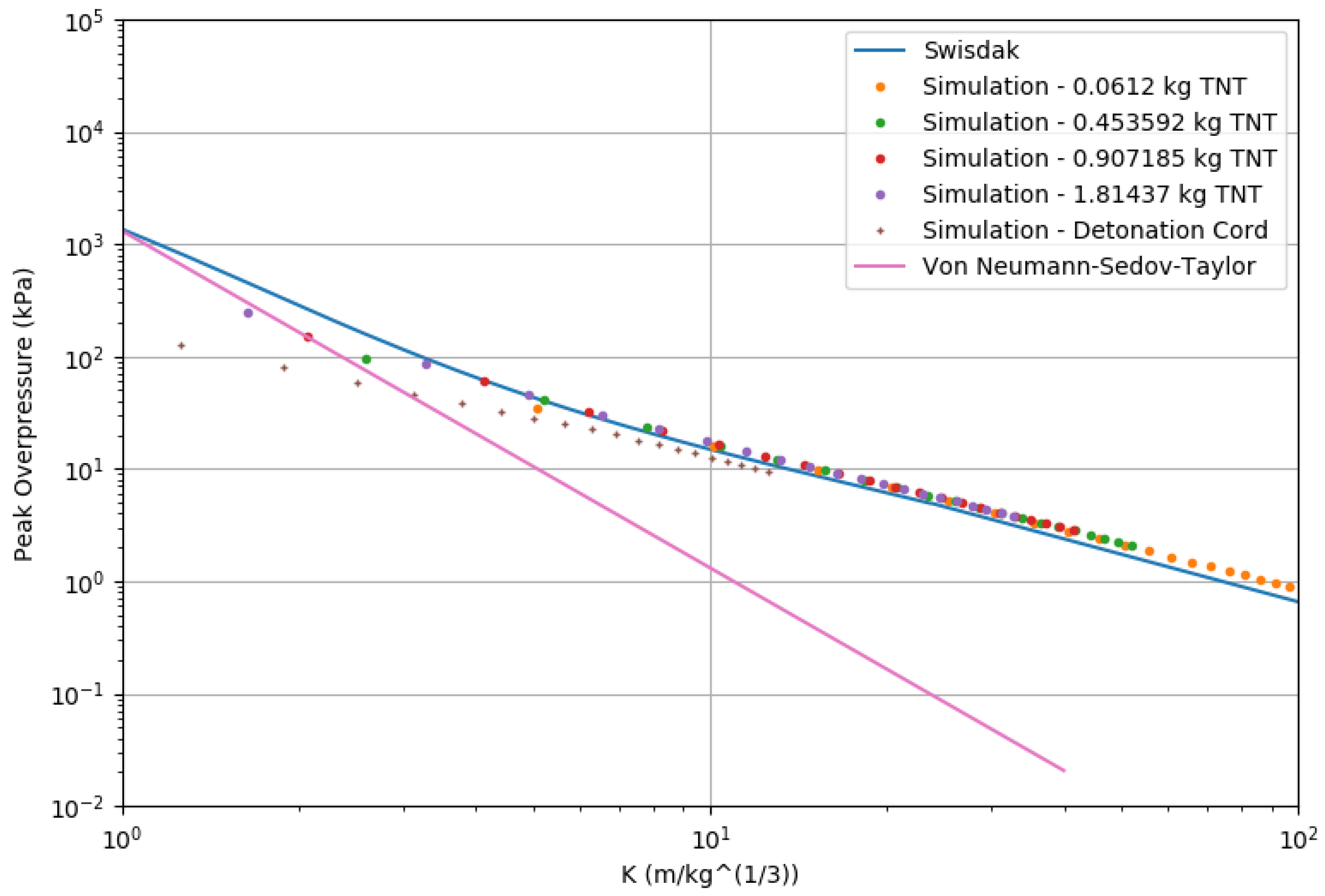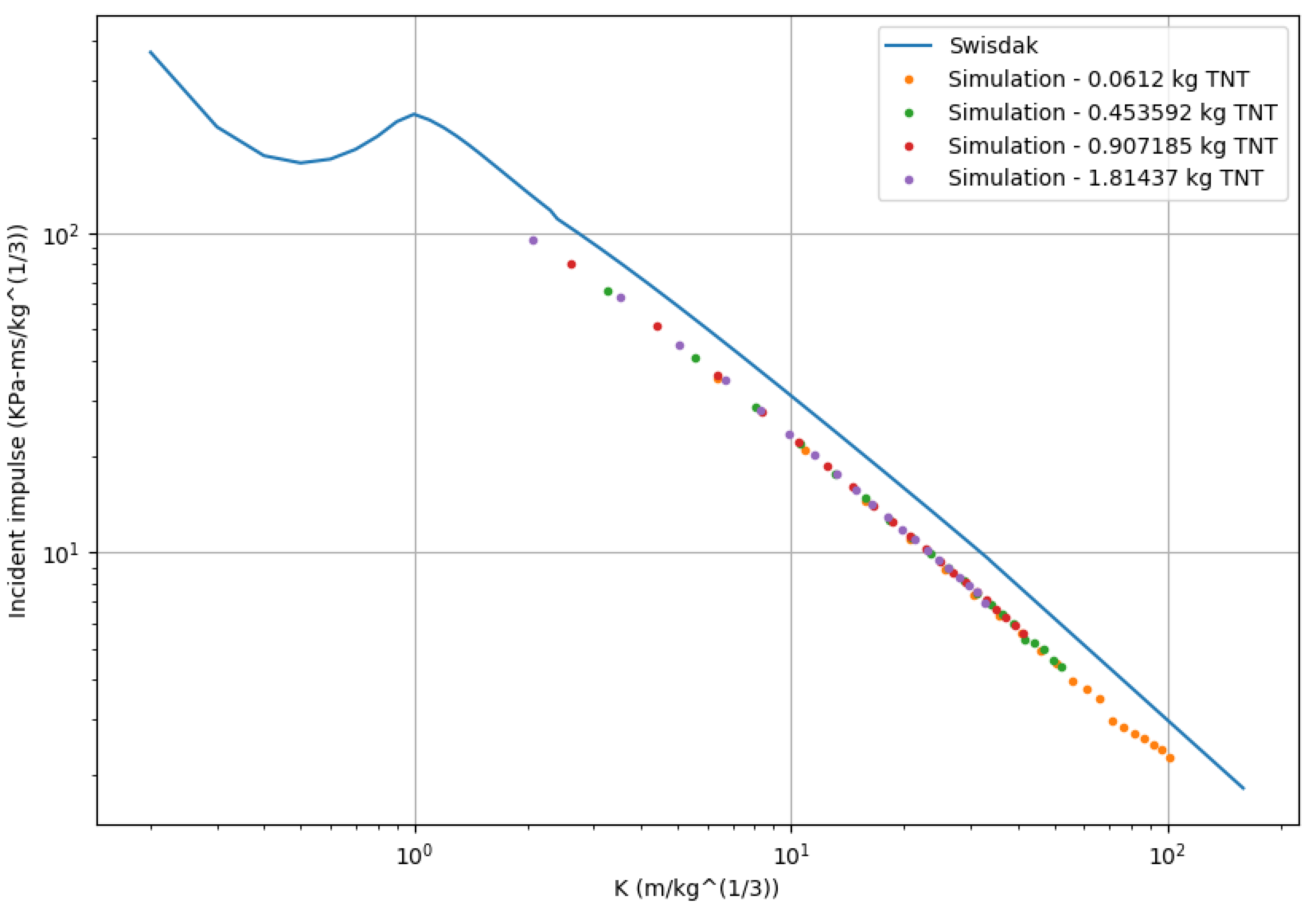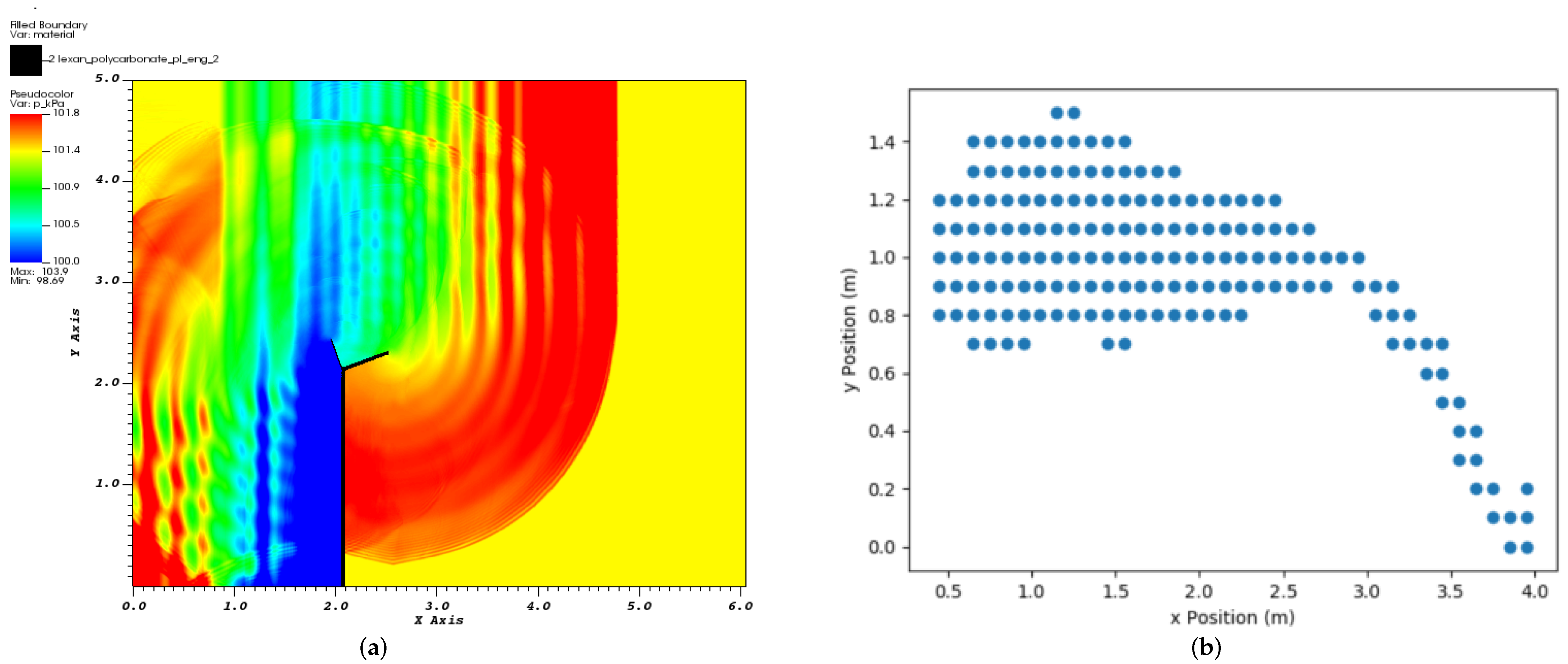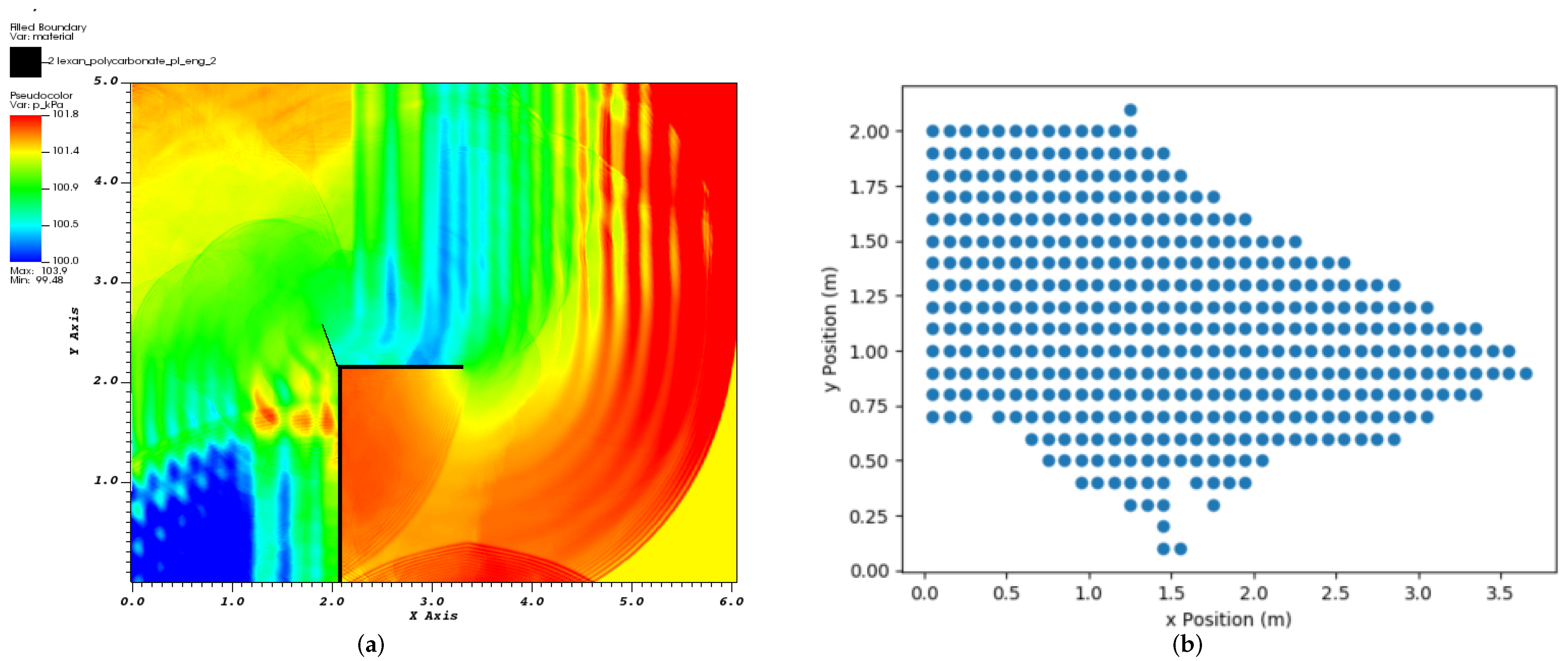1. Introduction
Understanding the structure of blast waves and the dynamics of their interactions with structures is key for mitigation and safety. The formation and propagation of these shock waves is a highly nonlinear dynamic process; thus, prediction of the incident waveforms and their corresponding blast overpressure and impulsive loads for a given scenario can be difficult. It is common for various government, military, and scientific institutions to prescribe criterion for safety from blast effects in terms of “
K factors”:
Here,
R is the distance from the explosive source and
W is the net explosive (TNT equivalent) weight. Allowable exposure for personnel, nearby structures, and withdrawal distances can be given in terms of these
K factors, which have been empirically correlated to values of incident overpressure and impulse. A figure regularly encountered in explosive safety documentation is the K328 criterion, often referred to as the “Public Withdrawal Distance”; calculated using units of ft/lb
1/3 this corresponds to a peak incident overpressure of 0.0655 psi, (0.4516 kPa) and is said to be a condition under which there is no probability of harm. Different safety guidelines have different requirements for personnel, but they are very commonly given in terms of these
K factors.
The empirical nexus of K factor correlation appears to be the work of Kingery [
1,
2]. The original data came from quite large (5, 20, 100, and 500 ton) hemispherical TNT events. Instrumentation at various distances measured arrival time, peak overpressure, and the duration of the positive pressure phase and the positive impulse. This same data set was later reinterpreted and extrapolated to include reflected pressures/impulse and shock velocities by Kingery and Bulmash [
3]. It is these fits which became the basis for more widespread application, and thus the empirical equations are often referred to as Kingerly-Bulmash (KB) curves. Swisdak [
4] provides a good overview of this history, along with improved equations fitting the same data. More recent fits by Jeon et al. [
5] claim to further simplify the curves with the same accuracy.
There is definite uncertainly in the accuracy of the KB curves and other analytic and empirical tools for predicting blast overpressure in a given case. Karlos et al. [
6,
7,
8] have investigated the structure of blast waves and their parameters for scaling and decay, including variations in explosive type, weight, and configuration on the resulting incident pulses. A recent review of analytical and empirical prediction methods by Ullah et al. [
9] shows a very large spread in the predicted blast overpressures and wave structures from various accepted sources. Recent repeated blast measurements from Stewart et al. [
10] show large variability in the measured results from what are ostensibly the same experiments. The recent experiment of Filice et al. [
11] provides more data and KB comparisons and variances for relatively nearby (2–5 m) and relatively small (100–400 g) explosives. In a review of the experimental literature vs. KB predictions, Rigby et al. [
12] state that the variation in experimental predictions is so large in nominally similar experiments that there is a valid question as to whether blast phenomena are inherently deterministic, or whether they should be viewed as fundamentally stochastic processes. Under this lens, KB and others may be viewed as useful only at predicting the order of magnitude of blast effects.
The question arises: can direct physics-based calculation of blast wave parameters provide more detailed and accurate predictions for a given case of interest?
The classical analytical result for the prediction of the evolution of a very strong explosion is the so-called Taylor–von Neumann–Sedov solution [
13,
14,
15,
16]. This applies only to spherical (1D) blasts and is derived under assumptions (point source, zero ambient pressure) that leave it applicable only for intermediate distances. Some of the earliest published attempts to simulate explosions under real conditions (i.e., into non-zero ambient pressure conditions) were performed by Brode [
17,
18] and Goldstine and von Neumann [
19].
More recently there have been various simulations performed in modern software packages aimed at the prediction of the evolution of blast waves. Ding et al. [
20,
21] recently presented the results of numerical simulations of very large TNT equivalent blasts and their resulting effects on near and far-field structures. Xue et al. [
22] modeled the whole process of explosive shockwave formation and propagation from relatively smaller blasts over larger distances. Sung and Chong have produced a fast-running semi-empirical method for the prediction of blast effects behind shielding barriers; this work includes uncertainty estimations when using KB-type charts [
23]. Giodo et al. compared empirical and numerical approaches to investigating the effects of free far-field blasts on masonry wall [
24]. Vannucci et al. [
25] provide analysis of a blast and shock propagation inside a monumental structure. Draganic and Varevac [
26] have provided a useful parametric study on the effects of numerical mesh size on the blast wave parameters.
It is easy to imagine situations (involving explosive training, demolitions, etc.) where relatively small explosions (comparable to 1 kg TNT) send overpressure waves towards personnel relatively far away (30–40 m). These blasts are very small compared to the conditions studied in the published literature or in the data informing KB-type predictions, but nevertheless may induce pressures and impulses in excess of safety guidelines (e.g., the Public Withdrawal Distance). Furthermore, the incident overpressure will be far below the ambient atmospheric pressures and will be difficult or impossible to accurately measure using easily available pressure gauges. Given that there are reasons to question the accuracy of KB-type predictions under these circumstances, research is needed to clarify the situation.
The purpose of this paper is to use numerical tools to investigate cases where very small charges produce relatively small incident overpressure at large distances which still exceed the safety guidelines of public withdrawal distance. The goals here are two-fold:
- 1.
to predict the structure and magnitude of the incident pressure waves in these cases and to compare to the available empirical blast curves;
- 2.
to investigate the efficacy of lightweight, modular barriers at mitigating incident overpressure waves to the desired levels.
Towards the first goal, free-field explosions of small hemispherical ground TNT charges into air are simulated out to a range of 40 m. Wave profiles obtained from the free-field simulations are subsequently employed as boundary conditions for dynamic wave-structure interaction models which investigate the second goal.
It is noted that a few different sets of units were used in the preparation of this work. Much of the original work conducted in blast load estimation was conducted in English units (ft/lb/ms/psi) (see for example the original Kingery report [
1]). For that reason, explosive range operators and field experts tend to think in terms of these units, and regulations often give quantities such as
K factors in these units. On the other hand, ALE3D hydrocode analyses are traditionally conducted in a special set of units (cm/g/μs/Mbar). The simulations described herein follow in this tradition. For the sake of consistency, all units in this paper will be given in terms of Si units (m/kg/ms/kPa). In some cases, English units will be listed concurrently.
4. Discussion
The calculated incident peak overpressures from the free-field hemispherical blast simulations show good agreement with the KB predictions in
Figure 10. Interestingly, the largest deviation from the KB curve appears to at the points closest to the explosions yielding the largest overpressure; these first three points lie closer to the von-Neumann-Taylor-Sedov prediction, which rapidly deviates from the Swisdak (KB) curve. The analytical prediction is only valid at an intermediate distance from large explosions; it breaks down near the explosion, as the point source assumption washes out details of the actual detonation event, but also in the very far-field, where the assumption that
in the ambient gas begins to corrupt the results as the incident overpressure approaches the ambient atmospheric pressure. Since the deviation of the data points from the empirical curve is likely within the experimental errors of the original fits, the fact that the data seem to jump from the analytical to the empirical curves may be coincidental. In the very far-field, the KB predictions seem to be doing a reasonable job at predicting the calculated overpressures, despite the fact that it is fit to data from explosions that were orders of magnitude larger.
As expected, the KB predictions do not do well at predicting the overpressures near the detonation cord. The asymmetrical blast wave from a long, thin cylindrical cord lit at one end reaches a nearby point at different times, making the peak pressure smaller than that predicted from a localized (hemispherical) source. However, with greater distance this time delay becomes smaller and the data appears to converge onto the KB curve.
There is a larger discrepancy between the KB-predicted and calculated incident impulses in
Figure 11. There is very good agreement in the slope of the data versus the curve, but the free-field simulations appear to uniformly under-predict the impulse relative to the KB curve by a relatively small amount. Given the better agreement in the peak overpressures, there may be some discrepancy in the shape or duration of the whole incident pressure wave. The source of this error could be numerical or physical. There may be low pressure effects to the waves which we not captured in the very large Kingery tests. Note the oscillations that appear in the smaller pressure time histories in
Figure 3. These appear after the sharp shock-like pressure spikes decay into more smooth waves traveling at sound speed. While these oscillations could be numerical effects, subsequent calculations were conducted to investigate this by changing mesh size and the position of the tracer nodes, which appeared to have no effects on the oscillations at distance. Thus it is possible that the oscillations in the far-field small pressure waves is in fact a physical phenomenon. This could in part explain the discrepancy in impulse when there is good agreement in the peak pressure magnitude. It is noted that similar but less pronounced oscillations also seem to appear in the farthest-field pressure histories in the works of Xue et al., Ding et al. [
20,
22]. There do not appear to be other curves available from similarly small charges at distance to compare with
Figure 4. Taking experimental measurements of incident pressures and impulses much smaller that atmospheric pressure very far away from small explosives is quite difficult.
It is further noted that the overall predictive accuracy in the subsequent blast-mitigation dynamic simulations is in part dependent on the accuracy of the predicted incident waves. At 36.576 m (120 ft), only the wave from the smallest (0.06123 kg) charge was mitigated down below the “Public Withdrawal Distance” value of 0.4516 kPa consistency behind the barrier under plane strain conditions; a large bubble was confirmed under a larger 3D simulation of a single barrier, though there were small regions near the edge and center where pressure rose higher in this case. The practical suggestion gleaned from this is that when implementing this type of barrier it may be wise to include more than one side by side to approximate the plane strain condition.
It is noted that the relevant hydrodynamics effects are likely more accurately captured in the 3D simulations. For example, mixing and turbulence are fundamentally 3D phenomena. Furthermore, resolution of any smaller-scale effects is inherently limited by the resolution of the simulation at those scales. However, due to the relatively low velocities and pressures these factors are not thought to have much influence in the cases studies here. Recent work has shown that purposefully exploiting wave interference can be useful in blast mitigation for incident strong shocks [
32].
Finally, the effectiveness of using TNT equivalence values to compare expected blast effects from different explosives depends on the situation [
33]. The present work has employed only a simple model of TNT with the simplest numerical detonation/burn assumptions. This seemed appropriate when gauging effects in the far-field, when the incident waves are sufficiently decoupled from the nuances of the blast and the blast products. Further work should be conducted to verify the accuracy of the KB charts and the predictions made here with other types of explosive, as well as to simulations with more sophisticated burn models (e.g., ignition and growth [
34]).
5. Conclusions
The present manuscript lays out two open problems (namely, what incident overpressure and impulses are felt at given distances from relatively small hemispherical ground charges, and how well can certain types of boundaries mitigate the incident overpressure below a certain threshold). It then describes the results of numerical investigations to attempt to answer these questions. A major motivating factor in this research is the uncertainty in the available empirical curve fits (e.g., Kingery–Bulmash). The source of this uncertainty is twofold: there is relatively large error between some of the original data and the available fitting curves, and the original data were taken for explosions that were many orders of magnitude larger than the charges investigated here. A major unknown remains the extent to which the assumed scaling described by Equation 1 (distance by the cubed root of charge weight) holds as weights become small. The free-field blast simulations presented here indicate that the strong shock of the initial blast smoothed out within the distance simulated and continued to propagate near the sound speed. The slowing of the wave speed is in fact predicted by the empirical Swisdak (KB) equations, but there remains uncertainty into how this change in the physics regime and the shape of the waveform effects the ultimate impulse at different scales. A benefit of the direct numerical calculations is the availability of the full waveforms in time at all distances in the simulation domain; this was further leveraged in the subsequent mitigation simulations. The ultimate shape of the incident pressure wave may be another degree of freedom which is not fully captured by the K factor scaling. This may explain why the simulations agree well with the peak overpressure and the slope of the impulse curves from Swisdak, but seem to consistently predict slightly smaller impulse magnitudes.
It was never assumed that the empirical curves would or should be “exact” predictors of incident overpressure and impulse for a given case. While this was a primary motivator for the present attempts for a direct physics-based prediction, it is also not assumed that these predictions will correspond exactly to any field case. Ultimately, the analyst, engineer, or responsible person must weigh uncertainty and risk to assess a given scenario. It is hoped that the present simulations (or others like them) could be used in uncertainty quantification efforts for blasts effects in wider-varying scenarios.
The blast-barrier mitigation simulations presented here were also motivated by this desire to mitigate risk and uphold safety standards. The “Public Withdrawal Distance” or “K328” threshold was taken as a more-or-less arbitrary datum against which to gauge effectiveness. The findings of this work should not be used to indicate whether a given scenario is “safe”, but rather to elucidate some of the physical mechanisms of mitigation in a dynamic blast event. Safety standards and acceptable risk vary from scenario to scenario; this work provides a methodology of analyzing the effectiveness of hypothetical tools to decrease risk.
The specific barrier designs presented here were somewhat ad hoc and experimental. The fairings were designed to reflect incident waves and further mitigate overpressure from wraparound over the top. The double fairing was intended to facilitate mitigation further by partially reflecting the incident wave from the backward-facing fairing. The “deep roof” concept was designed to provide even further mitigation. Each subsequent design was found to enhance mitigation. The results indicate that these types of simple barriers are in fact effective at mitigating incident pressure and impulse. They do not, however, eliminate these risks. Ultimately, distance from the source is the surest form of mitigation.
All conclusions herein would be much strengthened by specific field test data taken from experiments with the same charge weights and at the same distances, both in the free-field and behind the proposed barriers. As far as the author knows, no data exists that is a direct match for the scenarios described here. Currently available state-of-the-art instrumentation may be able to reliably measure the small dynamic pressures considered in this study. The experimental verification of these scenarios is outside of the scope of the present work.
